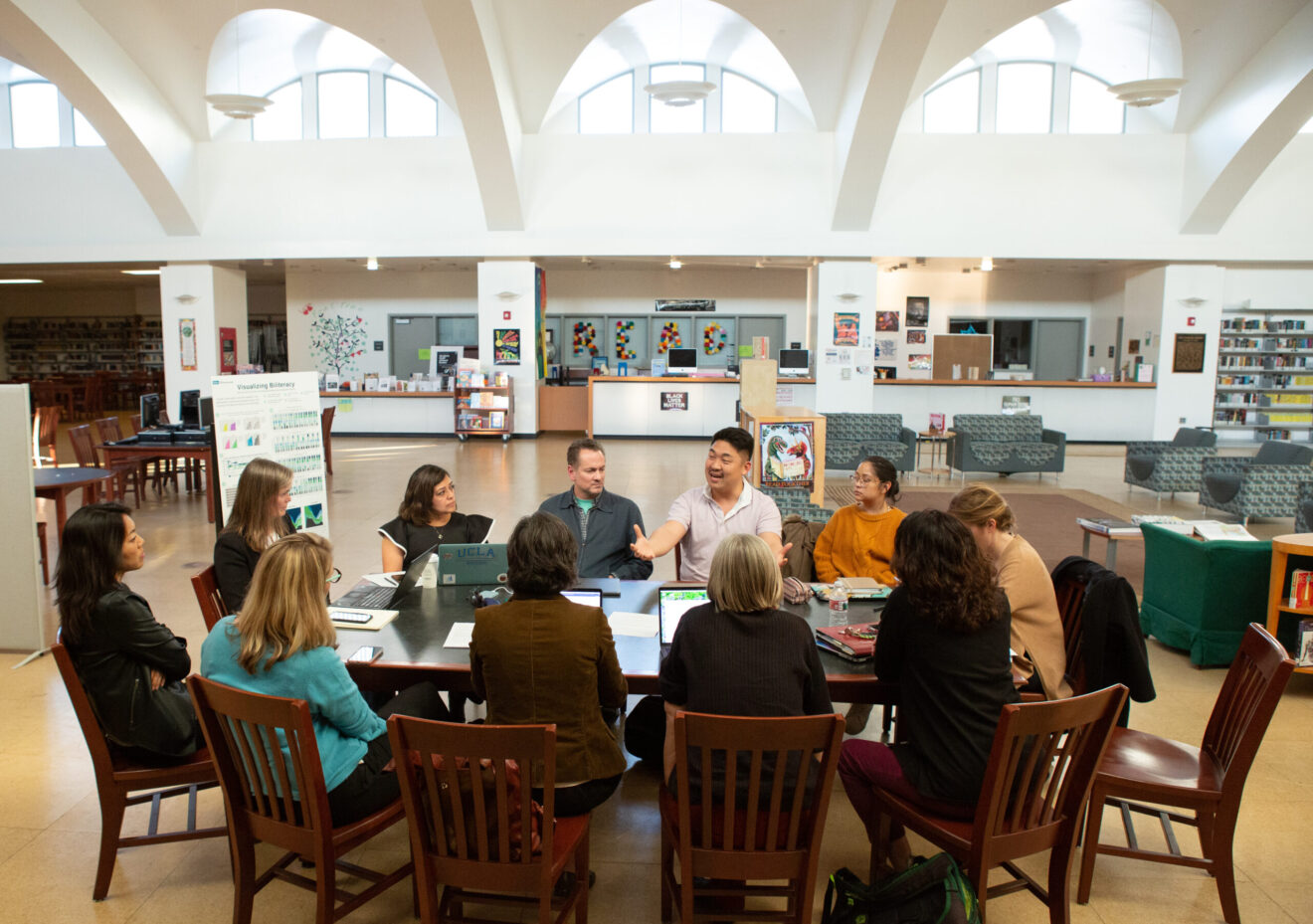I vividly recall a day as a middle-school teacher when I entered my classroom to find a vibrant, lime-green envelope on my desk. It sat next to a Starbucks coffee cup with a sticker displaying my favorite order — a soy green tea latte. Inside the envelope was a handwritten note from my principal, thanking me for always going above and beyond, particularly for creating a classroom space kids didn’t want to leave. That simple gesture meant the world to me, and I still have that card over a decade later.

How did he know about my love for a frothy matcha latte? As it turned out, during our first faculty meeting months earlier, he had designed an icebreaker where everyone shared detailed descriptions of their favorite morning beverages on brightly colored index cards as a way to get to know each other. Little did we know that he had an ulterior motive. Well played!
Working to build relationships lies at the core of teaching and learning, and its significance cannot be overstated in our work with educators. If we view our schools as half-empty, finding motivation and enthusiasm each day becomes difficult.
So, what tilts the scales and makes the coffee mug appear half full? It’s the way we connect with one another, genuinely listen and demonstrate appreciation through both grand and small gestures. To truly transform our education systems, we must prioritize the human side of teaching and leadership and foster a culture of trust and joy among educators. This is a fundamental and essential element in establishing a comprehensive and equitable multi-tiered system of support.
Acknowledge barriers, fears to build relationships
In order to cultivate a culture of open dialogue and empathy, it is important to acknowledge and address the barriers and fears that exist within our schools. One concrete way to foster a culture of open dialogue is through the use of anonymous surveys. These surveys provide a platform for stakeholders to provide feedback, and it is crucial to share the raw results with all involved parties.
You can provide prompts such as, “What is one barrier that prevents you from doing your best work,” or “Please complete this sentence, or “I would feel more prepared to meet the needs of all students if…” This approach allows everyone to reflect on and thematically analyze the responses together, gaining valuable insights into the collective concerns, barriers and fears within the educational community.
Another effective practice to build relationships is encouraging educators to envision cartoon angels and devils perched on their shoulders before having honest and candid conversations. This imaginative technique creates a safe and nonjudgmental space for honest dialogue. Taking the time to listen to the little cartoon devil provides an opportunity for individuals to express their genuine concerns and reservations about upcoming changes. The beauty of the activity is that they are not necessarily speaking for themselves, as it becomes an empathy exercise. Asking questions like “Why might someone struggle with this change according to that little devil on your shoulder?” acknowledges that resistance to change often stems from valid reasons.
Following this exercise, it is beneficial to repeat the process with the sweet little cherub. During this phase, educators can collectively brainstorm potential solutions and strategies to address the identified fears and concerns. This is not meant to minimize the validity of the barriers but to offer concrete solutions for addressing them. This activity consistently yields impressive outcomes as it fosters a collaborative atmosphere where ideas are generated and shared.
Additionally, personalized outreach plays an important role in establishing meaningful connections. Take the time to engage with individuals on an individual level, demonstrating genuine interest in their experiences, challenges and fears. If someone shares an incredibly honest fear, thank them for feeling safe enough to speak on behalf of people who share that fear. Going the extra mile, such as sending educators their favorite morning beverage, can further enhance the personal touch!
Effective communication
Effective communication is vital for strengthening relationships within the educational community. To establish clear channels of communication, it is important to utilize a variety of methods that cater to the diverse needs of different stakeholders. This may include newsletters, emails, social media platforms and online portals. With teachers, I have learned that regardless of the platform, short and sweet is the way to go.
As an assistant superintendent, I implemented a weekly email communication called “Curriculum Chirps.” The key principle behind this approach was to ensure that any communication from me was concise and easily digestible. I promised the Chirps would never exceed three bullet points, each less than 140 characters. This deliberate brevity ensured that my emails were actually read and captured the attention of busy educators. For those who wanted to explore additional information, relevant links were provided.
I also made it a point to add an element of fun to the Chirps, such as sharing amazing jokes (in my opinion, at least!) or creating a Chirp with only the clickbait, “Guess which teacher …” where the link led to obscure clues. This approach acknowledged the importance of engaging and connecting with teachers in a way that resonated with them. Sometimes, my former colleagues text me randomly to say, “I miss the Chirps!”
From my experience, bombarding overwhelmed and overworked educators with 2,000-word emails on a weekly basis is not the most effective method of connection. How did I know it? The feedback in anonymous surveys was crystal clear!
Collaboration is key
Promoting collaboration among educators is key to driving MTSS success. Create collaborative spaces, whether physical or virtual, where educators can come together to share resources, exchange ideas and foster cross-functional teams.
One concrete way to build relationships is to establish collaborative spaces within schools or districts, such as dedicated rooms or online platforms, where educators can connect and collaborate. If you don’t have a teacher’s room, find one — and please make it beautiful. Paint the walls a fun color; encourage teachers to bring in framed pictures of their families, friends, pets and favorite spaces to adorn the walls; put plants on the shelf; always have chill music playing; and ask the PTO to invest in a coffee machine. We need spaces where people feel valued, where they can retreat and where they feel appreciated. By providing a designated space for collaboration, stakeholders are encouraged to actively participate and contribute to the growth and success of the MTSS.
Facilitating professional learning communities is also instrumental in nurturing a culture of continuous learning and collaboration. PLCs create structured spaces for stakeholders to come together regularly to improve their practice. If we want to be inclusive of students in MTSS, we have to be inclusive of adults. Meeting the needs of diverse students is challenging work, but through collective efficacy, we can make significant progress.
As you review master schedules, consider how you can connect general educators with colleagues in special education, English language development, adjustment counselors, behavioral specialists and instructional coaches. Educators with diverse backgrounds need time to learn together, plan together and build relationships to create schools that effectively serve diverse students.
When implemented with integrity, in a culture of trust, educators have opportunities to share best practices, explore new strategies and collaboratively problem-solve challenges they encounter in the classroom. Through ongoing collaboration and dialogue, educators can refine their instructional approaches, enhance student support systems and align their efforts toward achieving the goals of the MTSS.
In conclusion, successful MTSS implementation hinges on our ability to cultivate strong relationships with educators. By fostering authentic connections, enhancing communication, promoting collaboration and building trust, we can create a supportive professional ecosystem that enables every learner to thrive. Just like the small gesture of a coffee cup and a handwritten note, it is the little things that make a big difference.
Katie Novak, Ed.D., is an education consultant, author, graduate instructor at the University of Pennsylvania and co-author with co-author Kristan Rodriguez, Ph.D., of ”In Support of Students: A Leader’s Guide to Equitable MTSS.” She has over 20 years’ experience in teaching and administration and has published 12 books focused on building inclusive and equitable classrooms, schools and systems.
Opinions expressed by SmartBrief contributors are their own.
_________________________
Subscribe to SmartBrief’s FREE email ASCD newsletter to see the latest hot topics in education. It’s among SmartBrief’s more than 250 industry-focused newsletters.
